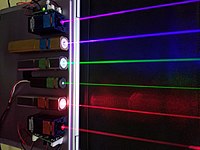
Photo from wikipedia
Laser terahertz emission microscopy (LTEM) has become a powerful tool for studying ultrafast dynamics and local fields in many different types of materials. This technique, which relies on acceleration of… Click to show full abstract
Laser terahertz emission microscopy (LTEM) has become a powerful tool for studying ultrafast dynamics and local fields in many different types of materials. This technique, which relies on acceleration of charge carriers in a material upon femtosecond excitation, can provide insight into the physics of charge transport, built-in fields, grain boundaries or surface states. We describe a new implementation of LTEM with a spatial resolution in the nanoscale regime based on a scattering-type near-field tip-based approach. We observe a spectral reshaping of the signal compared to conventional LTEM, which is analyzed using a resonant antenna model. Our experimental and computational results clarify the importance of the mechanisms for both the plasmonic in-coupling of the near-infrared pulses into the near field and the out-coupling of the generated terahertz pulses. We demonstrate a tip-size-limited spatial resolution of ∼20 nm by imaging a gold nanorod using terahertz emission from the underlying substrate. T...
Journal Title: ACS Photonics
Year Published: 2017
Link to full text (if available)
Share on Social Media: Sign Up to like & get
recommendations!